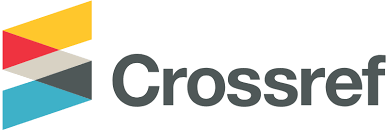Impulsive Buying Tendency among Emerging Adults Using Pay Later on E-Commerce Platforms
Abstract
Findings indicate that most pay later users show high impulsive buying tendencies, with affective dimension being stronger than cognitive aspect. These insights can help educate emerging adults on responsible pay later usage.
Keywords
Full Text:
PDFReferences
Agabon, M. B., & Bastida, G. L. (2022). Financial management and saving behavior of
deped division personnel as mediated by impulse buying. International Journal of Research in Education Humanities and Commerce, 3(3). https://ijrehc.com/doc/ijrehc03_23.pdf
Amelia, P. N., Fidiansa, P. A., & Risa, C. S. (2023). Fenomena penggunaan pay later di
kalangan mahasiswa. In Prosiding Seminar Nasional Ilmu Ilmu Sosial (SNIIS), 2, 176-187.
Anggono, Y. D. (2020). Analisa pengaruh perceived ease of use terhadap intention to
buy dengan perceived usefulness sebagai variabel intervening pada aplikasi e-commerce Tokopedia. Jurnal Strategi Pemasaran, 7(1), 9.
Annur, C. M. (2023, June 23). Ini Produk yang Banyak Dibeli Pengguna Pay Later saat
Belanja Online. Databoks. Retrieved May 20, 2024, from https://databoks.katadata.co.id/datapublish/2023/06/23/ini-produk-yang-banyak-dibeli-pengguna-paylater-saat-belanja-online
Arnett, J. J. (2015). Adolescence and emerging adulthood: A cultural approach. London:
Pearson. Education.
Aisyah, S., Harahap, M. I., Nurbaiti, N., & Rokan, M. K. (2023). The factors influencing
behavioral intention fintech lending (paylater) among generation Z Indonesian Muslims and Islamic consumption ethics views. EKONOMIKA SYARIAH: Journal of Economic Studies, 7(1), 01-20.
Ascasaputra, A., & Arimbi, K. P. (2022). Analisis pembelian impulsif pada
marketplace pada masa pandemi Covid 19. Jurnal Ilmiah Manajemen, 17(2).
Azwar, S. (1993). "Kelompok subjek ini memiliki harga diri yang rendah"; kok, tahu...? Buletin Psikologi, 1(2), 13-17.
Badgaiyan, A. J., Verma, A., & Dixit, S. (2016). Impulsive buying tendency: Measuring
important relationships with a new perspective and an indigenous scale. IIMB Management Review, 28(4), 186-199.
Beatty, S. E., & Ferrell, M. E. (1998). Impulse buying: Modeling its precursors. Journal
of Retailing, 74(2), 169-191.
Capelli, S., & Helme-Guizon, A. (2008). Temperament: measurement and impact on
consumer behaviour. Recherche et Applications en Marketing, 23(1), 1-19.
Catriana, E., & Ika, A. (2023, June). Survei Kredivo: Bayar "PayLater" Lebih Diminati
ketimbang Transfer Bank. Kompas Money. https://money.kompas.com/read/2023/06/14/155941726/survei-kredivo-bayar-paylater-lebih-diminati-ketimbang-transfer-bank
Cresswell, J. W. (2012). Educational research: Planning, conducting and evaluating
quantitative and qualitative research (4th Ed). Boston: Pearson Education Inc.
Duke, P., Andy, M., & Andrew, C. (2019). Insights into payments payment methods
report 2019; Innovations in the way we pay. The Paypers, 144, 1–143.
Dyatmika, P. B. P., Weliangan, H., & Huda, N. (2023). Impulsive buying pada dewasa
awal pengguna Shopee pay later ditinjau dari mindfulness. Arjwa: Jurnal Psikologi, 2(4), 179-193.
Ek Styvén, M., Foster, T., & Wallström, Å. (2017). Impulse buying tendencies among
online shoppers in Sweden. Journal of Research in Interactive Marketing, 11(4), 416-431.
Febrilia, I., & Warokka, A. (2021). Consumer traits and situational factors: Exploring
the consumer's online impulse buying in the pandemic time. Social Sciences & Humanities Open, 4(1).
Firmansyah, D. (2022). Teknik pengambilan sampel umum dalam metodologi
penelitian: Literature review. Jurnal Ilmiah Pendidikan Holistik (JIPH), 1(2), 85-114.
Foroughi, A., Buang, N. A., Senik, Z. C., & Hajmisadeghi, R. S. (2013). Impulse
buying behavior and moderating role of gender among Iranian shoppers. Journal of Basic and Applied Scientific Research, 3(4), 760-769.
Gogoi, B. J. (2020). Do impulsive buying influence compulsive buying?. Academy of
Marketing Studies Journal, 24(4), 1-15.
Hardyansah, H., Wolor, C. W., & Rahmi, R. (2024). Analisis impulsive buying
e-commerce. Journal of Business Application, 3(1), 19-36.
Henrietta, P. (2012). Impulsive buying pada dewasa awal di Yogyakarta. Jurnal
Psikologi, 11(2).
Hilmi, L. D., & Pratika, Y. (2021). Paylater feature: impulsive buying driver for
e-commerce in indonesia. International Journal of Economics, Business and Accounting Research (IJEBAR), 5(2), 63-76.
Iyer, G. R., Blut, M., Xiao, S. H., & Grewal, D. (2020). Impulse buying: a meta-analytic
review. Journal of the academy of marketing science, 48, 384-404.
Jain, V., Malviya, B., & Arya, S. (2021). An overview of electronic commerce
(e-Commerce). Journal of Contemporary Issues in Business and Government, 27(3), 665-670.
Khadafi, M. (2023, July). Orang Indonesia Nunggak Bayar Pay Later Rp 3,28 Triliun.
CNBC Indonesia. https://www.cnbcindonesia.com/market/20230710094743-17-452717/orang-indonesia-nunggak-bayar-pay-later-rp-328-triliun.
Koentary, A. S. S. (2023). The effect of parasocial relationship on online impulsive
buying tendency: Exploring the role of financial literacy and self-control. TAZKIYA Journal of Psychology, 11(2), 114-131.
Kuper, N., von Garrel, A. S., Wiernik, B. M., Phan, L. V., Modersitzki, N., &
Rauthmann, J. F. (2024). Distinguishing four types of Person × Situation interactions: An integrative framework and empirical examination. Journal of Personality and Social Psychology, 126(2), 282–311. https://doi.org/10.1037/pspp0000473
Lanctot J., Poulin F. (2018). Emerging adulthood features and adjustment: A
person-centered approach. Emerging Adulthood, 6(2), 91–103.
Loudon, D. L., & Bitta, A. J. Della. (2002). Consumer Behavior: Concepts and
Applications (4th edition). McGraw Hill Education.
Manurung (2022). Pengaruh literasi keuangan dan gaya hidup terhadap berbelanja
online pengguna Shopee (studi kasus mahasiswa manajemen Bhayangkara Jakarta Raya angkatan 2018). Cakrawala Repositori IMWI, 5(2).
Maria Ek Styvén, Foster, T., & Wallström, Å. (2017). Impulse buying tendencies
among online shoppers in Sweden: An International Journal. Journal of Research in Interactive Marketing, 11(4), 416-431. https://doi.org/10.1108/JRIM-05-2016-0054
Muawanah, I. (2019). Fenomena maraknya coffee shop sebagai gejala gaya hidup anak
muda di kota Metro (studi pada mahasiswa IAIN Metro) (Doctoral dissertation, IAIN Metro).
Nice, M. L., & Joseph, M. (2023). The features of emerging adulthood and
individuation: Relations and differences by college-going status, age, and living situation. Emerging Adulthood, 11(2), 271-287.
Otoritas Jasa Keuangan. (2023, November). Infografis Hasil Survei Nasional Literasi
dan Inklusi Keuangan Tahun 2022. OJK. https://ojk.go.id/id/berita-dan-kegiatan/info-terkini/Pages/Infografis-Survei-Nasional-Literasi-dan-Inklusi-Keuangan-Tahun-2022.aspx
Pradipto, Y. D., Winata, C., Murti, K., & Azizah, A. (2016). Think again before you
buy: The relationship between self-regulation and impulsive buying behaviors among Jakarta young adults. Procedia-Social and Behavioral Sciences, 222, 177-185.
Pratika, Y., Salahudin, S., Riyanto, D. W. U., & Ambarwati, T. (2020). Analysis of pay
later payment system on online shopping in Indonesia. Journal of Economics, Business, & Accountancy Ventura, 23(3), 329-339.
Prastiwi, I. E., & Fitria, T. N. (2021). Konsep Paylater Online Shopping dalam
Pandangan Ekonomi Islam. Jurnal Ilmiah Ekonomi Islam, 7(1), 425-432.
Putri, D. A., & Pradananta, G. (2024). Analisis pengaruh penggunaan fitur spaylater
pada aplikasi shopee terhadap perilaku konsumtif mahasiswa. Jurnal Ilmiah Manajemen & Bisnis, 6(3).
Qomariyah, A., Qibtiyah, G. A., & Bemby, F. A. W. (2022). Financial literacy,
impulsive buying behavior, and the Z-gen. Review of Integrative Business and Economics Research, 11, 164-178.
Restike, K. P., Presasti, D., Fitriani, D. I., & Ciptani, M. K. (2024). Pengaruh literasi
keuangan, perilaku pembelian impulsif, dan gaya hidup terhadap penggunaan Shopee pay later gen Z. Jurnal Akuntansi Bisnis, 22(1), 100-113.
Rook, D. W., & Fisher, R. J. (1995). Normative influences on impulsive buying
behavior. Journal of consumer research, 22(3), 305-313.
Said, L., Rodin, W. M., & Fariany, G. R. (2023). Online purchase decision of gen Z
students at Shopee marketplace. International Journal of Professional Business Review: Int. J. Prof. Bus. Rev., 8(5), 15.
Sari, Rahmatika. (2021). Pengaruh penggunaan paylater terhadap perilaku impulse
buying pengguna e-commerce di Indonesia. Jurnal Riset Bisnis dan Investasi, 7(1), 44.
Shahid, Q., & Razaq, L. (2017). Demonetisation for changing payment behaviour and
building platforms. Journal of Payments Strategy & Systems, 11(2), 158-167.
Siregar, E. Y., Nababan, E. M., Ginting, E. R., Nainggolan, B. A., Ritonga, D. L., &
Nababan, D. (2022). Perlunya pembinaan terhadap dewasa awal dalam menghadapi tugas perkembangannya. Lumen: Jurnal Pendidikan Agama Katekese dan Pastoral, 1(2), 16-22.
Stifani, S., & Rafida, V. (2023). Pengaruh penggunaan paylater terhadap kepuasan
pelanggan melalui keputusan pembelian di aplikasi Shopee. Jurnal Pendidikan Tata Niaga (JPTN), 11(3), 313-324.
Sudirjo, F., Lotte, L. N. A., Sutaguna, I. N. T., Risdwiyanto, A., & Yusuf, M. (2023).
The influence of generation Z consumer behavior on purchase motivation in e-commerce Shopee. Profit: Jurnal Manajemen, Bisnis dan Akuntansi, 2(2), 110-126.
Tarantang, J., Awwaliyah, A., Astuti, M., & Munawaroh, M. (2019). Perkembangan
sistem pembayaran digital. Jurnal Qardhul Hasan: Kajian Ekonomi dan Bisnis Islam, 3(1), 83-96. https://e-journal.iain-palangkaraya.ac.id/index.php/qardh/article/view/1442/0
Thakur, C., Diwekar, A., Reddy, B. J., & Gajjala, N. (2020). A study of the online
impulse buying behaviour during COVID-19 pandemic. International Journal of Research in Engineering, Science and Management, 3(9), 86-90.
Utama, A., Sawitri, H. S. R., Haryanto, B., & Wahyudi, L. (2021). Impulse buying: The
influence of impulse buying tendency, urge to buy and gender on impulse buying of the retail customers. Journal of Distribution Science, 19(7), 101-111.
Verplanken, B., & Herabadi, A. (2001). Individual differences in impulse buying
tendency: Feeling and no thinking. European Journal of Personality, 15(1 SUPPL.), 71–83. https://doi.org/10.1002/per.423
Youn, S., & Faber, R. J. (2000). Impulse buying: its relation to personality traits and
cues. ACR North American Advances.
Zhang, X., Prybutok, V. R., & Strutton, D. (2007). Modeling influences on impulse
purchasing behaviors during online marketing transactions. Journal of Marketing Theory and Practice, 15(1), 79-89.
Zhang, M., & Shi, G. (2022). Consumers’ impulsive buying behavior in online shopping
based on the influence of social presence. Computational Intelligence and Neuroscience.
DOI: https://doi.org/10.46336/ijbesd.v6i1.897
Refbacks
- There are currently no refbacks.
Copyright (c) 2025 International Journal of Business, Economics, and Social Development

This work is licensed under a Creative Commons Attribution 4.0 International License.
Published By:
IJBESD: Jalan Riung Ampuh No. 3, Riung Bandung, Kota Bandung 40295, Jawa Barat, Indonesia
IJBESD Indexed By:
 This work is licensed under a Creative Commons Attribution 4.0 International License.
This work is licensed under a Creative Commons Attribution 4.0 International License.







.png)



